Detailed Analysis: Rights-Based Approach to Health in the EU and UK
VerifiedAdded on 2022/09/05
|19
|4984
|20
Essay
AI Summary
This essay provides a comprehensive analysis of the rights-based approach to healthcare within the European Union (EU) and the United Kingdom (UK). It begins by examining the challenges migrants face in accessing healthcare services within EU countries, highlighting the growing ethnically diverse populations and their specific healthcare needs. The essay then explores the European Court of Human Rights' (ECHR) role in addressing HIV discrimination, particularly in employment settings, referencing the case of IB versus Greece. It also assesses the challenges the ECHR faces in enforcing its decisions. Finally, the essay delves into the healthcare situation in the UK, specifically concerning migrants' access to services. The analysis covers legislative policies, healthcare plans, and integration strategies designed to ensure equitable access to healthcare, including mental health services, for migrant populations. The essay emphasizes the importance of equity, diversity management, and the protection of human rights in healthcare provision.
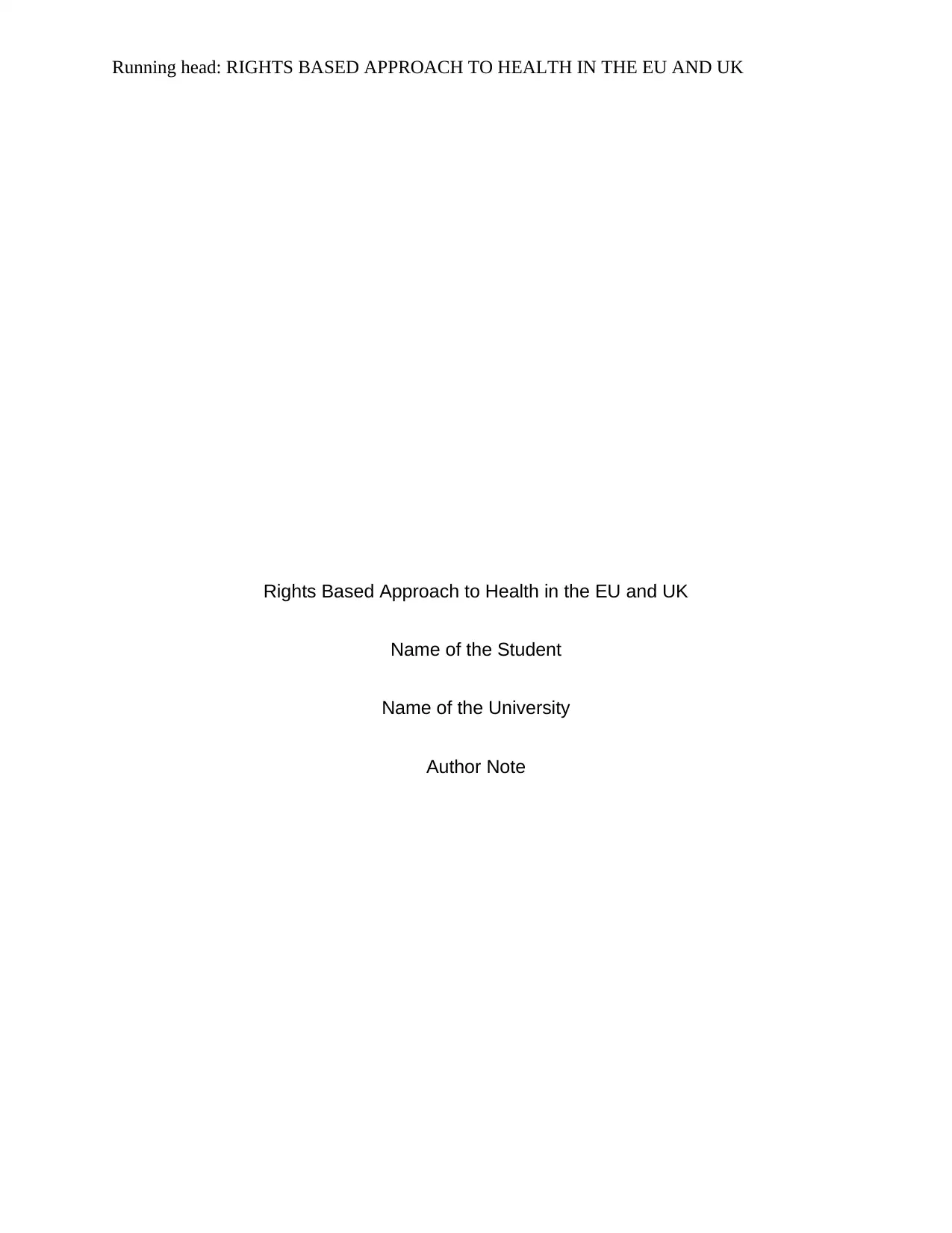
Running head: RIGHTS BASED APPROACH TO HEALTH IN THE EU AND UK
Rights Based Approach to Health in the EU and UK
Name of the Student
Name of the University
Author Note
Rights Based Approach to Health in the EU and UK
Name of the Student
Name of the University
Author Note
Paraphrase This Document
Need a fresh take? Get an instant paraphrase of this document with our AI Paraphraser
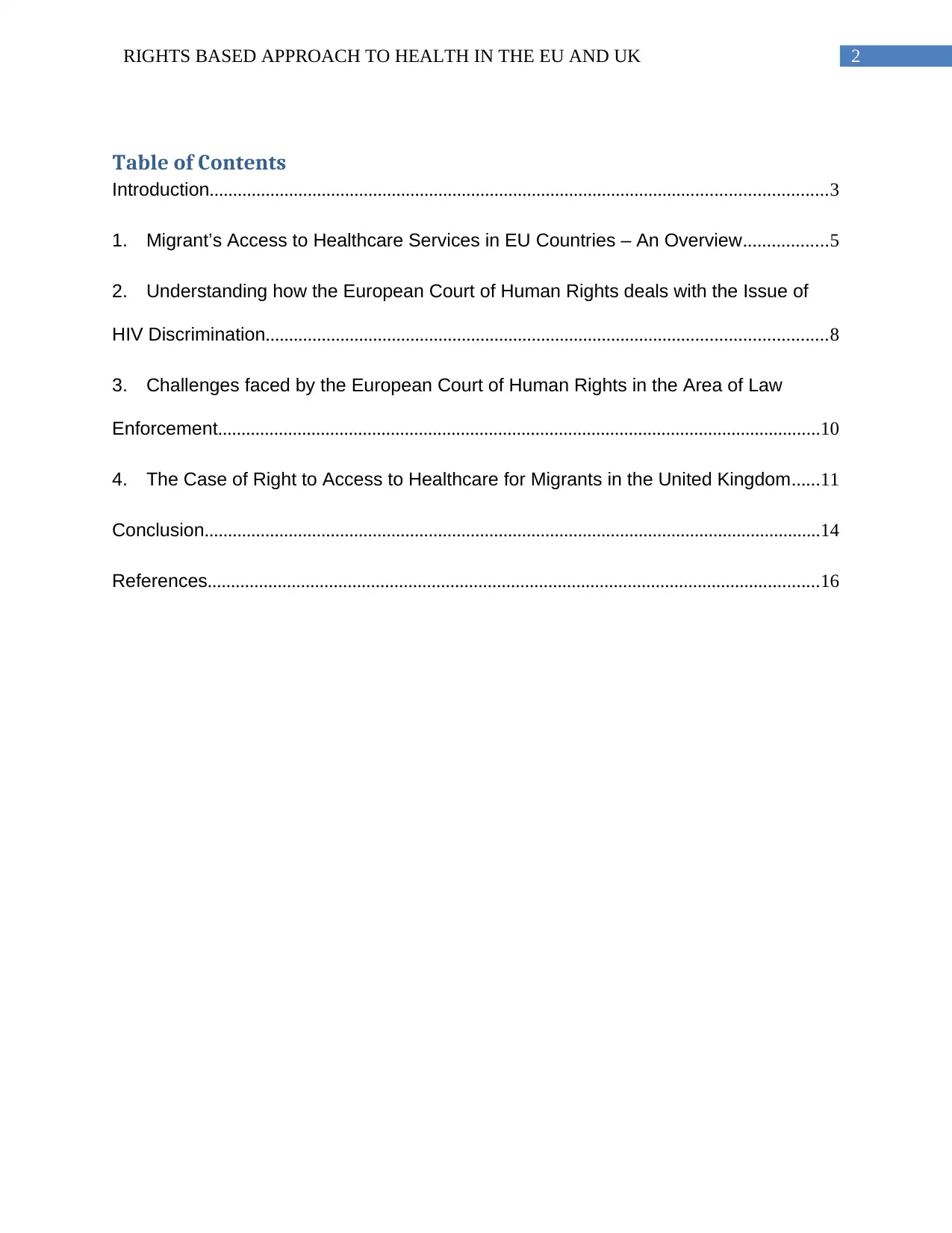
2RIGHTS BASED APPROACH TO HEALTH IN THE EU AND UK
Table of Contents
Introduction....................................................................................................................................3
1. Migrant’s Access to Healthcare Services in EU Countries – An Overview..................5
2. Understanding how the European Court of Human Rights deals with the Issue of
HIV Discrimination........................................................................................................................8
3. Challenges faced by the European Court of Human Rights in the Area of Law
Enforcement.................................................................................................................................10
4. The Case of Right to Access to Healthcare for Migrants in the United Kingdom......11
Conclusion....................................................................................................................................14
References...................................................................................................................................16
Table of Contents
Introduction....................................................................................................................................3
1. Migrant’s Access to Healthcare Services in EU Countries – An Overview..................5
2. Understanding how the European Court of Human Rights deals with the Issue of
HIV Discrimination........................................................................................................................8
3. Challenges faced by the European Court of Human Rights in the Area of Law
Enforcement.................................................................................................................................10
4. The Case of Right to Access to Healthcare for Migrants in the United Kingdom......11
Conclusion....................................................................................................................................14
References...................................................................................................................................16
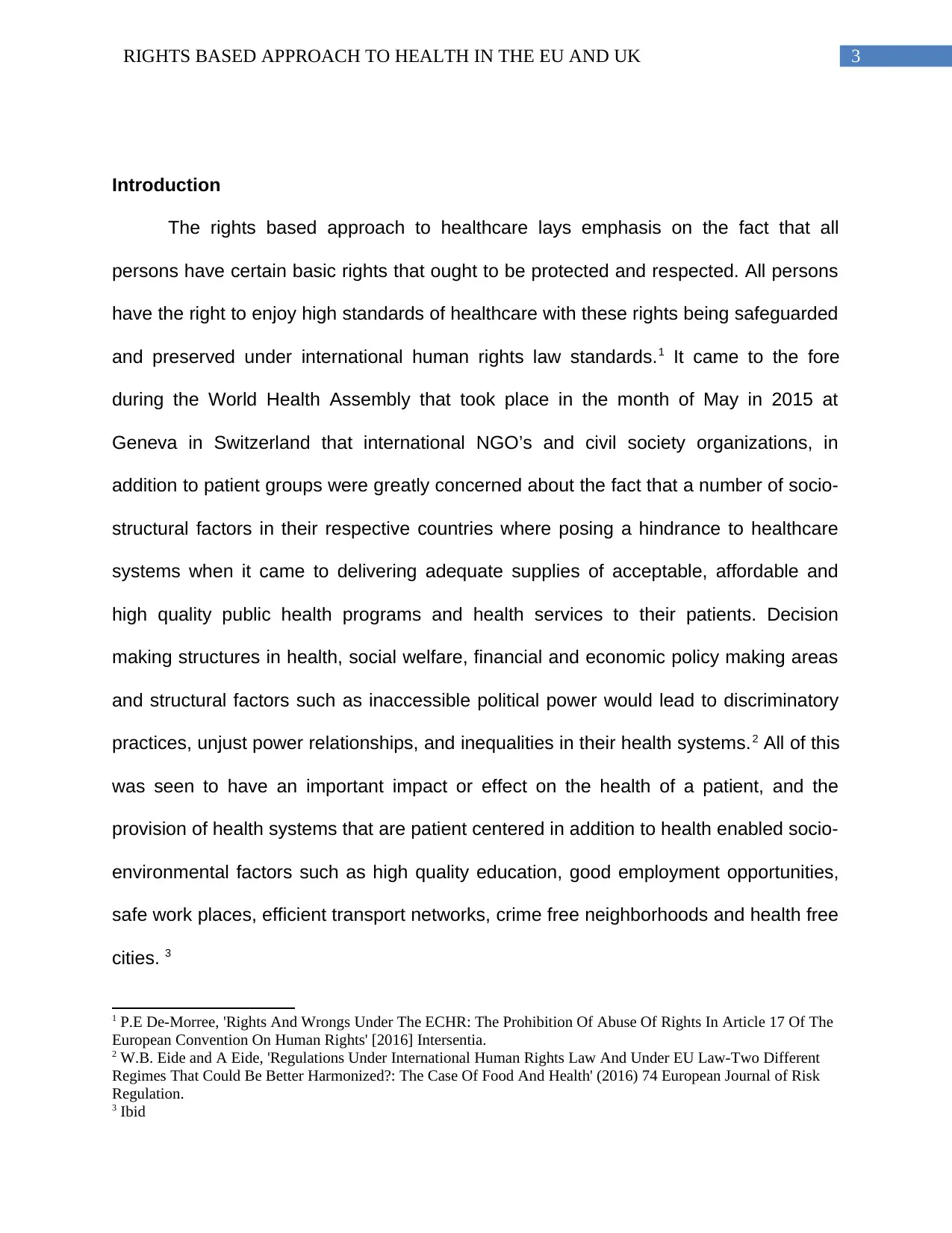
3RIGHTS BASED APPROACH TO HEALTH IN THE EU AND UK
Introduction
The rights based approach to healthcare lays emphasis on the fact that all
persons have certain basic rights that ought to be protected and respected. All persons
have the right to enjoy high standards of healthcare with these rights being safeguarded
and preserved under international human rights law standards.1 It came to the fore
during the World Health Assembly that took place in the month of May in 2015 at
Geneva in Switzerland that international NGO’s and civil society organizations, in
addition to patient groups were greatly concerned about the fact that a number of socio-
structural factors in their respective countries where posing a hindrance to healthcare
systems when it came to delivering adequate supplies of acceptable, affordable and
high quality public health programs and health services to their patients. Decision
making structures in health, social welfare, financial and economic policy making areas
and structural factors such as inaccessible political power would lead to discriminatory
practices, unjust power relationships, and inequalities in their health systems.2 All of this
was seen to have an important impact or effect on the health of a patient, and the
provision of health systems that are patient centered in addition to health enabled socio-
environmental factors such as high quality education, good employment opportunities,
safe work places, efficient transport networks, crime free neighborhoods and health free
cities. 3
1 P.E De-Morree, 'Rights And Wrongs Under The ECHR: The Prohibition Of Abuse Of Rights In Article 17 Of The
European Convention On Human Rights' [2016] Intersentia.
2 W.B. Eide and A Eide, 'Regulations Under International Human Rights Law And Under EU Law-Two Different
Regimes That Could Be Better Harmonized?: The Case Of Food And Health' (2016) 74 European Journal of Risk
Regulation.
3 Ibid
Introduction
The rights based approach to healthcare lays emphasis on the fact that all
persons have certain basic rights that ought to be protected and respected. All persons
have the right to enjoy high standards of healthcare with these rights being safeguarded
and preserved under international human rights law standards.1 It came to the fore
during the World Health Assembly that took place in the month of May in 2015 at
Geneva in Switzerland that international NGO’s and civil society organizations, in
addition to patient groups were greatly concerned about the fact that a number of socio-
structural factors in their respective countries where posing a hindrance to healthcare
systems when it came to delivering adequate supplies of acceptable, affordable and
high quality public health programs and health services to their patients. Decision
making structures in health, social welfare, financial and economic policy making areas
and structural factors such as inaccessible political power would lead to discriminatory
practices, unjust power relationships, and inequalities in their health systems.2 All of this
was seen to have an important impact or effect on the health of a patient, and the
provision of health systems that are patient centered in addition to health enabled socio-
environmental factors such as high quality education, good employment opportunities,
safe work places, efficient transport networks, crime free neighborhoods and health free
cities. 3
1 P.E De-Morree, 'Rights And Wrongs Under The ECHR: The Prohibition Of Abuse Of Rights In Article 17 Of The
European Convention On Human Rights' [2016] Intersentia.
2 W.B. Eide and A Eide, 'Regulations Under International Human Rights Law And Under EU Law-Two Different
Regimes That Could Be Better Harmonized?: The Case Of Food And Health' (2016) 74 European Journal of Risk
Regulation.
3 Ibid
⊘ This is a preview!⊘
Do you want full access?
Subscribe today to unlock all pages.

Trusted by 1+ million students worldwide
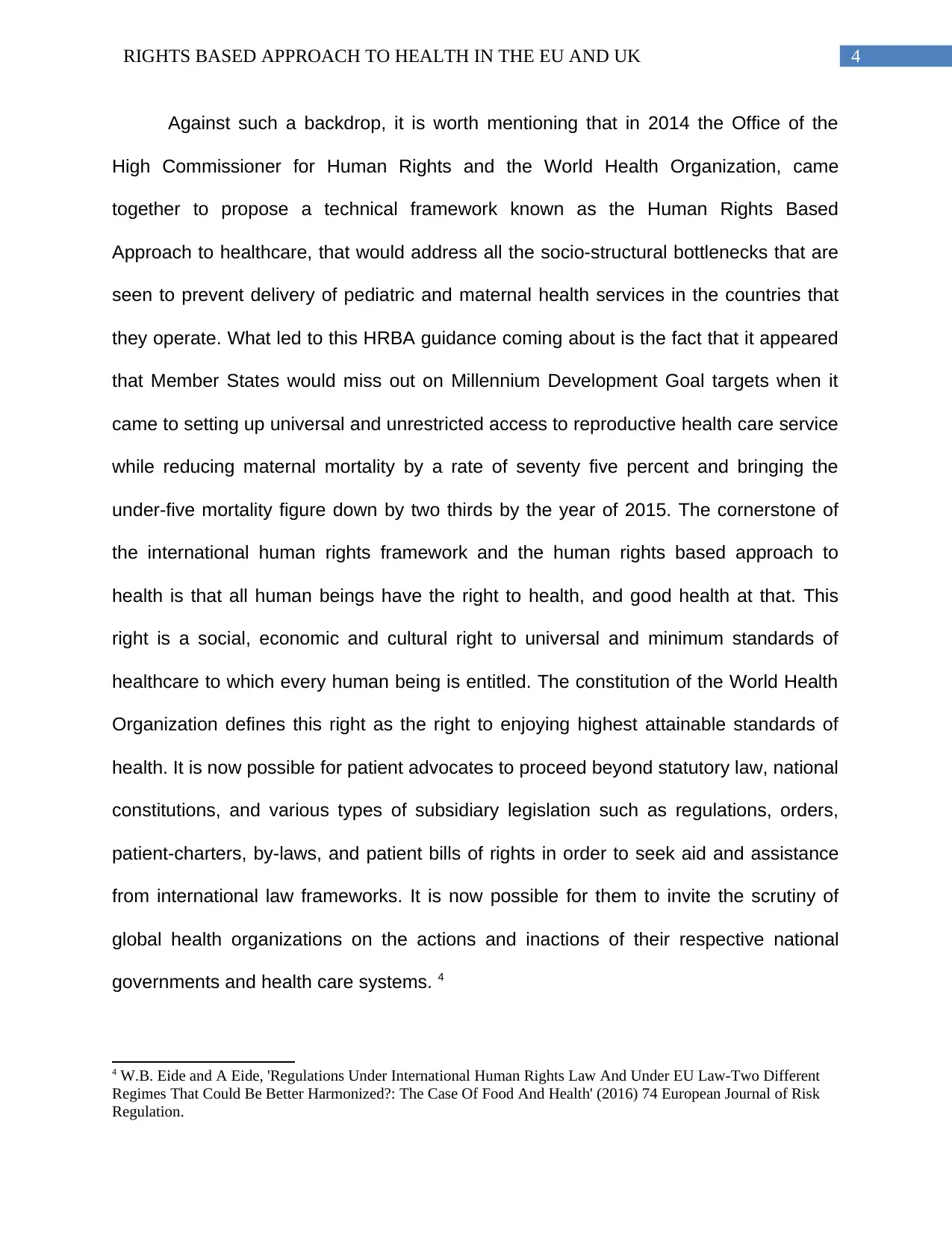
4RIGHTS BASED APPROACH TO HEALTH IN THE EU AND UK
Against such a backdrop, it is worth mentioning that in 2014 the Office of the
High Commissioner for Human Rights and the World Health Organization, came
together to propose a technical framework known as the Human Rights Based
Approach to healthcare, that would address all the socio-structural bottlenecks that are
seen to prevent delivery of pediatric and maternal health services in the countries that
they operate. What led to this HRBA guidance coming about is the fact that it appeared
that Member States would miss out on Millennium Development Goal targets when it
came to setting up universal and unrestricted access to reproductive health care service
while reducing maternal mortality by a rate of seventy five percent and bringing the
under-five mortality figure down by two thirds by the year of 2015. The cornerstone of
the international human rights framework and the human rights based approach to
health is that all human beings have the right to health, and good health at that. This
right is a social, economic and cultural right to universal and minimum standards of
healthcare to which every human being is entitled. The constitution of the World Health
Organization defines this right as the right to enjoying highest attainable standards of
health. It is now possible for patient advocates to proceed beyond statutory law, national
constitutions, and various types of subsidiary legislation such as regulations, orders,
patient-charters, by-laws, and patient bills of rights in order to seek aid and assistance
from international law frameworks. It is now possible for them to invite the scrutiny of
global health organizations on the actions and inactions of their respective national
governments and health care systems. 4
4 W.B. Eide and A Eide, 'Regulations Under International Human Rights Law And Under EU Law-Two Different
Regimes That Could Be Better Harmonized?: The Case Of Food And Health' (2016) 74 European Journal of Risk
Regulation.
Against such a backdrop, it is worth mentioning that in 2014 the Office of the
High Commissioner for Human Rights and the World Health Organization, came
together to propose a technical framework known as the Human Rights Based
Approach to healthcare, that would address all the socio-structural bottlenecks that are
seen to prevent delivery of pediatric and maternal health services in the countries that
they operate. What led to this HRBA guidance coming about is the fact that it appeared
that Member States would miss out on Millennium Development Goal targets when it
came to setting up universal and unrestricted access to reproductive health care service
while reducing maternal mortality by a rate of seventy five percent and bringing the
under-five mortality figure down by two thirds by the year of 2015. The cornerstone of
the international human rights framework and the human rights based approach to
health is that all human beings have the right to health, and good health at that. This
right is a social, economic and cultural right to universal and minimum standards of
healthcare to which every human being is entitled. The constitution of the World Health
Organization defines this right as the right to enjoying highest attainable standards of
health. It is now possible for patient advocates to proceed beyond statutory law, national
constitutions, and various types of subsidiary legislation such as regulations, orders,
patient-charters, by-laws, and patient bills of rights in order to seek aid and assistance
from international law frameworks. It is now possible for them to invite the scrutiny of
global health organizations on the actions and inactions of their respective national
governments and health care systems. 4
4 W.B. Eide and A Eide, 'Regulations Under International Human Rights Law And Under EU Law-Two Different
Regimes That Could Be Better Harmonized?: The Case Of Food And Health' (2016) 74 European Journal of Risk
Regulation.
Paraphrase This Document
Need a fresh take? Get an instant paraphrase of this document with our AI Paraphraser
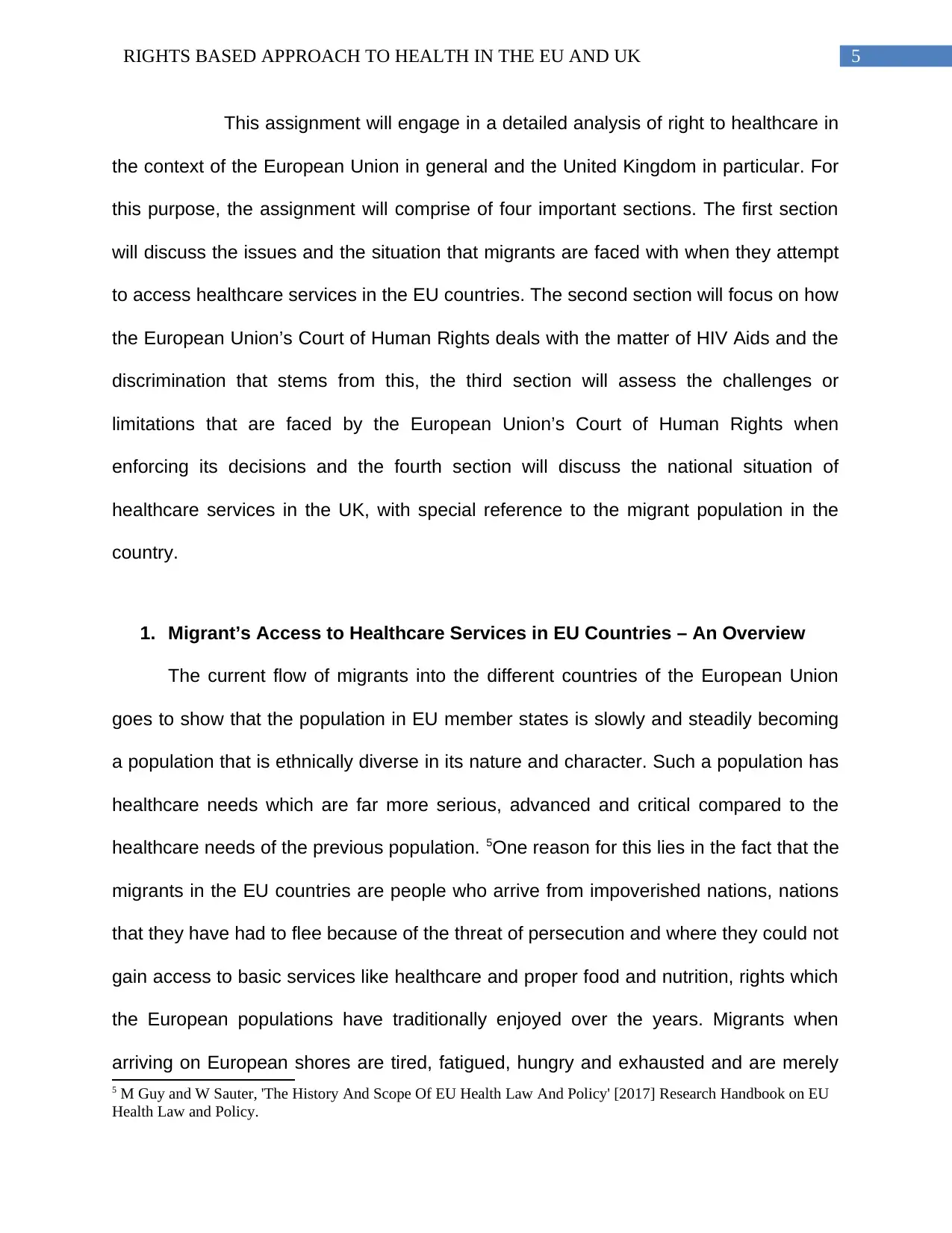
5RIGHTS BASED APPROACH TO HEALTH IN THE EU AND UK
This assignment will engage in a detailed analysis of right to healthcare in
the context of the European Union in general and the United Kingdom in particular. For
this purpose, the assignment will comprise of four important sections. The first section
will discuss the issues and the situation that migrants are faced with when they attempt
to access healthcare services in the EU countries. The second section will focus on how
the European Union’s Court of Human Rights deals with the matter of HIV Aids and the
discrimination that stems from this, the third section will assess the challenges or
limitations that are faced by the European Union’s Court of Human Rights when
enforcing its decisions and the fourth section will discuss the national situation of
healthcare services in the UK, with special reference to the migrant population in the
country.
1. Migrant’s Access to Healthcare Services in EU Countries – An Overview
The current flow of migrants into the different countries of the European Union
goes to show that the population in EU member states is slowly and steadily becoming
a population that is ethnically diverse in its nature and character. Such a population has
healthcare needs which are far more serious, advanced and critical compared to the
healthcare needs of the previous population. 5One reason for this lies in the fact that the
migrants in the EU countries are people who arrive from impoverished nations, nations
that they have had to flee because of the threat of persecution and where they could not
gain access to basic services like healthcare and proper food and nutrition, rights which
the European populations have traditionally enjoyed over the years. Migrants when
arriving on European shores are tired, fatigued, hungry and exhausted and are merely
5 M Guy and W Sauter, 'The History And Scope Of EU Health Law And Policy' [2017] Research Handbook on EU
Health Law and Policy.
This assignment will engage in a detailed analysis of right to healthcare in
the context of the European Union in general and the United Kingdom in particular. For
this purpose, the assignment will comprise of four important sections. The first section
will discuss the issues and the situation that migrants are faced with when they attempt
to access healthcare services in the EU countries. The second section will focus on how
the European Union’s Court of Human Rights deals with the matter of HIV Aids and the
discrimination that stems from this, the third section will assess the challenges or
limitations that are faced by the European Union’s Court of Human Rights when
enforcing its decisions and the fourth section will discuss the national situation of
healthcare services in the UK, with special reference to the migrant population in the
country.
1. Migrant’s Access to Healthcare Services in EU Countries – An Overview
The current flow of migrants into the different countries of the European Union
goes to show that the population in EU member states is slowly and steadily becoming
a population that is ethnically diverse in its nature and character. Such a population has
healthcare needs which are far more serious, advanced and critical compared to the
healthcare needs of the previous population. 5One reason for this lies in the fact that the
migrants in the EU countries are people who arrive from impoverished nations, nations
that they have had to flee because of the threat of persecution and where they could not
gain access to basic services like healthcare and proper food and nutrition, rights which
the European populations have traditionally enjoyed over the years. Migrants when
arriving on European shores are tired, fatigued, hungry and exhausted and are merely
5 M Guy and W Sauter, 'The History And Scope Of EU Health Law And Policy' [2017] Research Handbook on EU
Health Law and Policy.
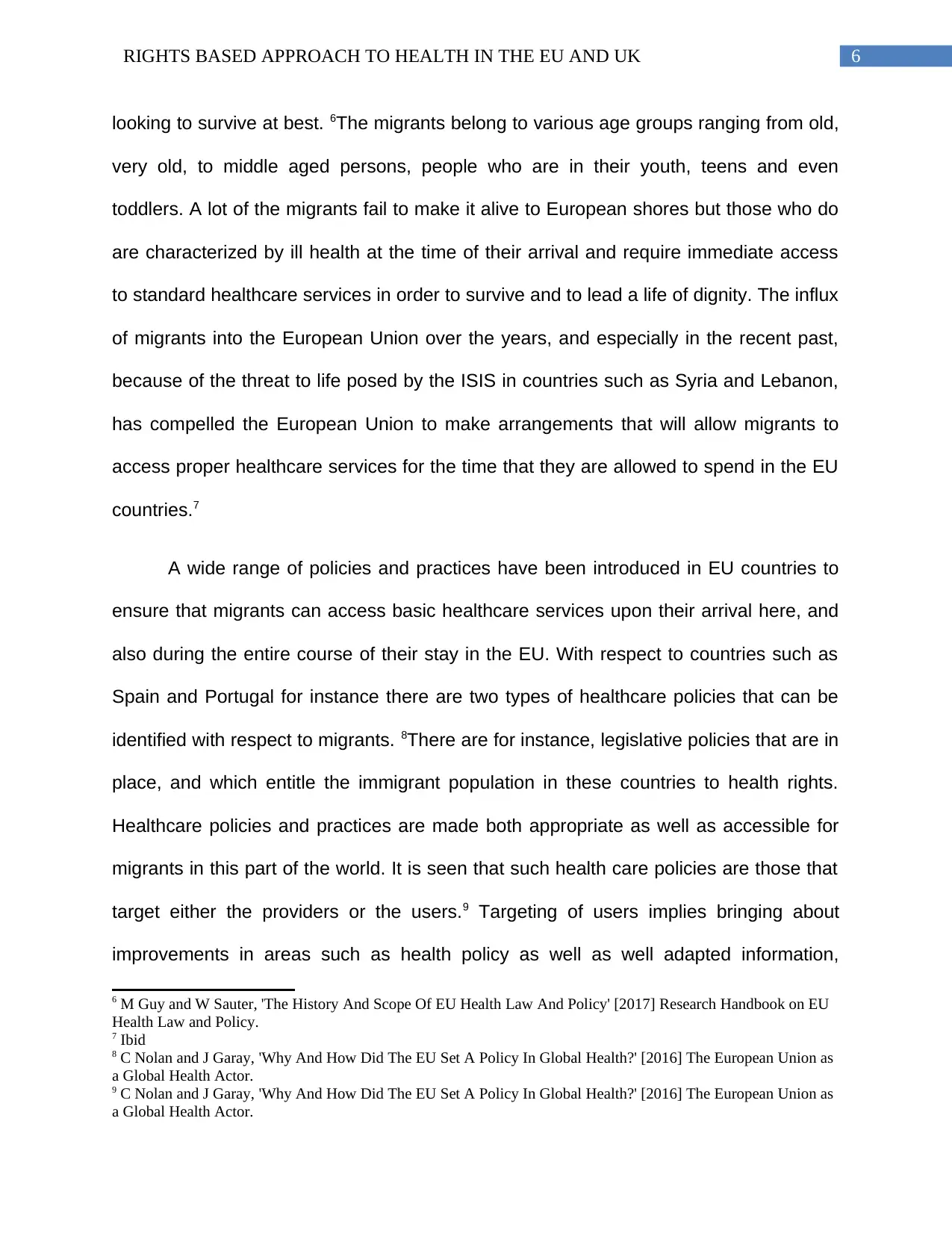
6RIGHTS BASED APPROACH TO HEALTH IN THE EU AND UK
looking to survive at best. 6The migrants belong to various age groups ranging from old,
very old, to middle aged persons, people who are in their youth, teens and even
toddlers. A lot of the migrants fail to make it alive to European shores but those who do
are characterized by ill health at the time of their arrival and require immediate access
to standard healthcare services in order to survive and to lead a life of dignity. The influx
of migrants into the European Union over the years, and especially in the recent past,
because of the threat to life posed by the ISIS in countries such as Syria and Lebanon,
has compelled the European Union to make arrangements that will allow migrants to
access proper healthcare services for the time that they are allowed to spend in the EU
countries.7
A wide range of policies and practices have been introduced in EU countries to
ensure that migrants can access basic healthcare services upon their arrival here, and
also during the entire course of their stay in the EU. With respect to countries such as
Spain and Portugal for instance there are two types of healthcare policies that can be
identified with respect to migrants. 8There are for instance, legislative policies that are in
place, and which entitle the immigrant population in these countries to health rights.
Healthcare policies and practices are made both appropriate as well as accessible for
migrants in this part of the world. It is seen that such health care policies are those that
target either the providers or the users.9 Targeting of users implies bringing about
improvements in areas such as health policy as well as well adapted information,
6 M Guy and W Sauter, 'The History And Scope Of EU Health Law And Policy' [2017] Research Handbook on EU
Health Law and Policy.
7 Ibid
8 C Nolan and J Garay, 'Why And How Did The EU Set A Policy In Global Health?' [2016] The European Union as
a Global Health Actor.
9 C Nolan and J Garay, 'Why And How Did The EU Set A Policy In Global Health?' [2016] The European Union as
a Global Health Actor.
looking to survive at best. 6The migrants belong to various age groups ranging from old,
very old, to middle aged persons, people who are in their youth, teens and even
toddlers. A lot of the migrants fail to make it alive to European shores but those who do
are characterized by ill health at the time of their arrival and require immediate access
to standard healthcare services in order to survive and to lead a life of dignity. The influx
of migrants into the European Union over the years, and especially in the recent past,
because of the threat to life posed by the ISIS in countries such as Syria and Lebanon,
has compelled the European Union to make arrangements that will allow migrants to
access proper healthcare services for the time that they are allowed to spend in the EU
countries.7
A wide range of policies and practices have been introduced in EU countries to
ensure that migrants can access basic healthcare services upon their arrival here, and
also during the entire course of their stay in the EU. With respect to countries such as
Spain and Portugal for instance there are two types of healthcare policies that can be
identified with respect to migrants. 8There are for instance, legislative policies that are in
place, and which entitle the immigrant population in these countries to health rights.
Healthcare policies and practices are made both appropriate as well as accessible for
migrants in this part of the world. It is seen that such health care policies are those that
target either the providers or the users.9 Targeting of users implies bringing about
improvements in areas such as health policy as well as well adapted information,
6 M Guy and W Sauter, 'The History And Scope Of EU Health Law And Policy' [2017] Research Handbook on EU
Health Law and Policy.
7 Ibid
8 C Nolan and J Garay, 'Why And How Did The EU Set A Policy In Global Health?' [2016] The European Union as
a Global Health Actor.
9 C Nolan and J Garay, 'Why And How Did The EU Set A Policy In Global Health?' [2016] The European Union as
a Global Health Actor.
⊘ This is a preview!⊘
Do you want full access?
Subscribe today to unlock all pages.

Trusted by 1+ million students worldwide
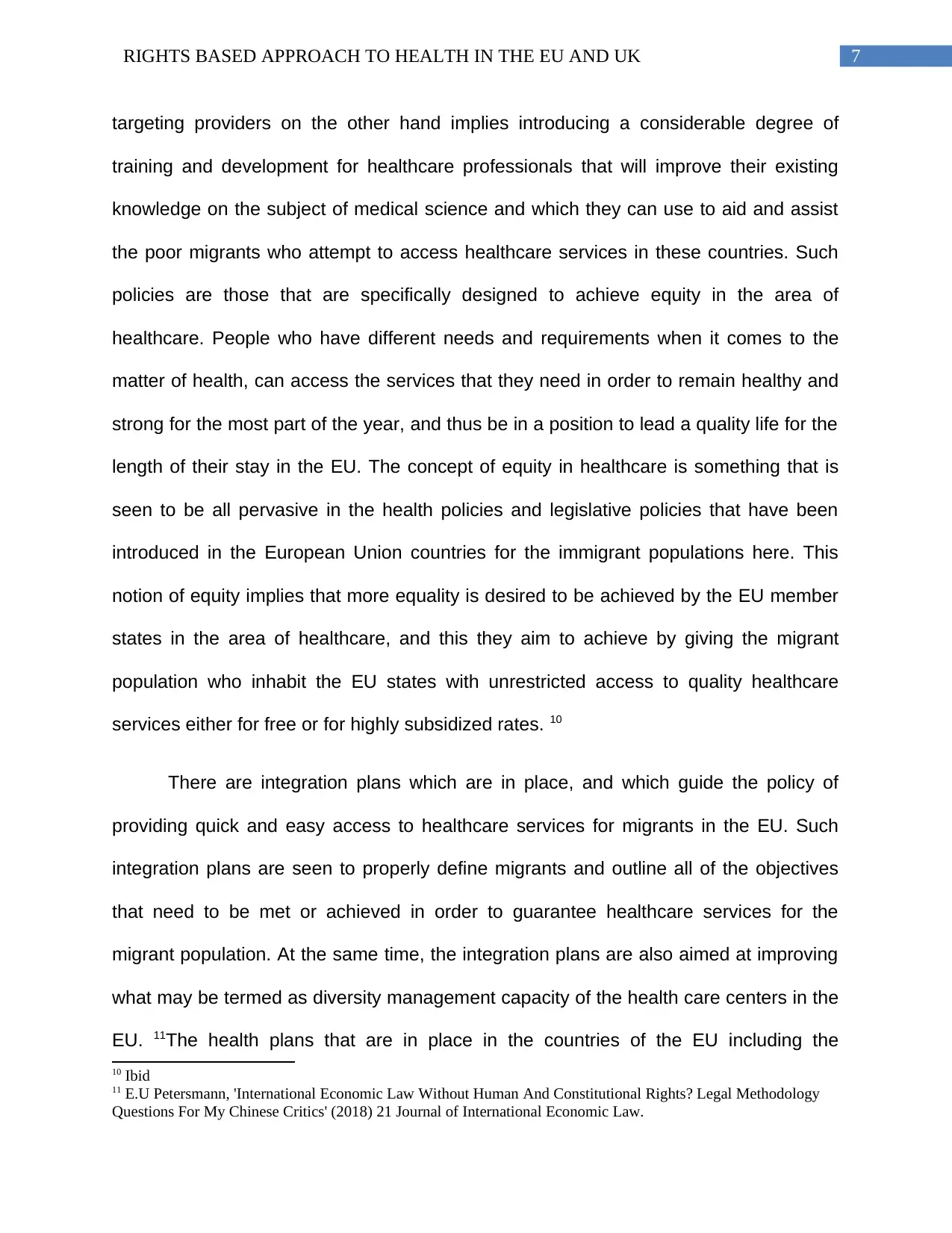
7RIGHTS BASED APPROACH TO HEALTH IN THE EU AND UK
targeting providers on the other hand implies introducing a considerable degree of
training and development for healthcare professionals that will improve their existing
knowledge on the subject of medical science and which they can use to aid and assist
the poor migrants who attempt to access healthcare services in these countries. Such
policies are those that are specifically designed to achieve equity in the area of
healthcare. People who have different needs and requirements when it comes to the
matter of health, can access the services that they need in order to remain healthy and
strong for the most part of the year, and thus be in a position to lead a quality life for the
length of their stay in the EU. The concept of equity in healthcare is something that is
seen to be all pervasive in the health policies and legislative policies that have been
introduced in the European Union countries for the immigrant populations here. This
notion of equity implies that more equality is desired to be achieved by the EU member
states in the area of healthcare, and this they aim to achieve by giving the migrant
population who inhabit the EU states with unrestricted access to quality healthcare
services either for free or for highly subsidized rates. 10
There are integration plans which are in place, and which guide the policy of
providing quick and easy access to healthcare services for migrants in the EU. Such
integration plans are seen to properly define migrants and outline all of the objectives
that need to be met or achieved in order to guarantee healthcare services for the
migrant population. At the same time, the integration plans are also aimed at improving
what may be termed as diversity management capacity of the health care centers in the
EU. 11The health plans that are in place in the countries of the EU including the
10 Ibid
11 E.U Petersmann, 'International Economic Law Without Human And Constitutional Rights? Legal Methodology
Questions For My Chinese Critics' (2018) 21 Journal of International Economic Law.
targeting providers on the other hand implies introducing a considerable degree of
training and development for healthcare professionals that will improve their existing
knowledge on the subject of medical science and which they can use to aid and assist
the poor migrants who attempt to access healthcare services in these countries. Such
policies are those that are specifically designed to achieve equity in the area of
healthcare. People who have different needs and requirements when it comes to the
matter of health, can access the services that they need in order to remain healthy and
strong for the most part of the year, and thus be in a position to lead a quality life for the
length of their stay in the EU. The concept of equity in healthcare is something that is
seen to be all pervasive in the health policies and legislative policies that have been
introduced in the European Union countries for the immigrant populations here. This
notion of equity implies that more equality is desired to be achieved by the EU member
states in the area of healthcare, and this they aim to achieve by giving the migrant
population who inhabit the EU states with unrestricted access to quality healthcare
services either for free or for highly subsidized rates. 10
There are integration plans which are in place, and which guide the policy of
providing quick and easy access to healthcare services for migrants in the EU. Such
integration plans are seen to properly define migrants and outline all of the objectives
that need to be met or achieved in order to guarantee healthcare services for the
migrant population. At the same time, the integration plans are also aimed at improving
what may be termed as diversity management capacity of the health care centers in the
EU. 11The health plans that are in place in the countries of the EU including the
10 Ibid
11 E.U Petersmann, 'International Economic Law Without Human And Constitutional Rights? Legal Methodology
Questions For My Chinese Critics' (2018) 21 Journal of International Economic Law.
Paraphrase This Document
Need a fresh take? Get an instant paraphrase of this document with our AI Paraphraser
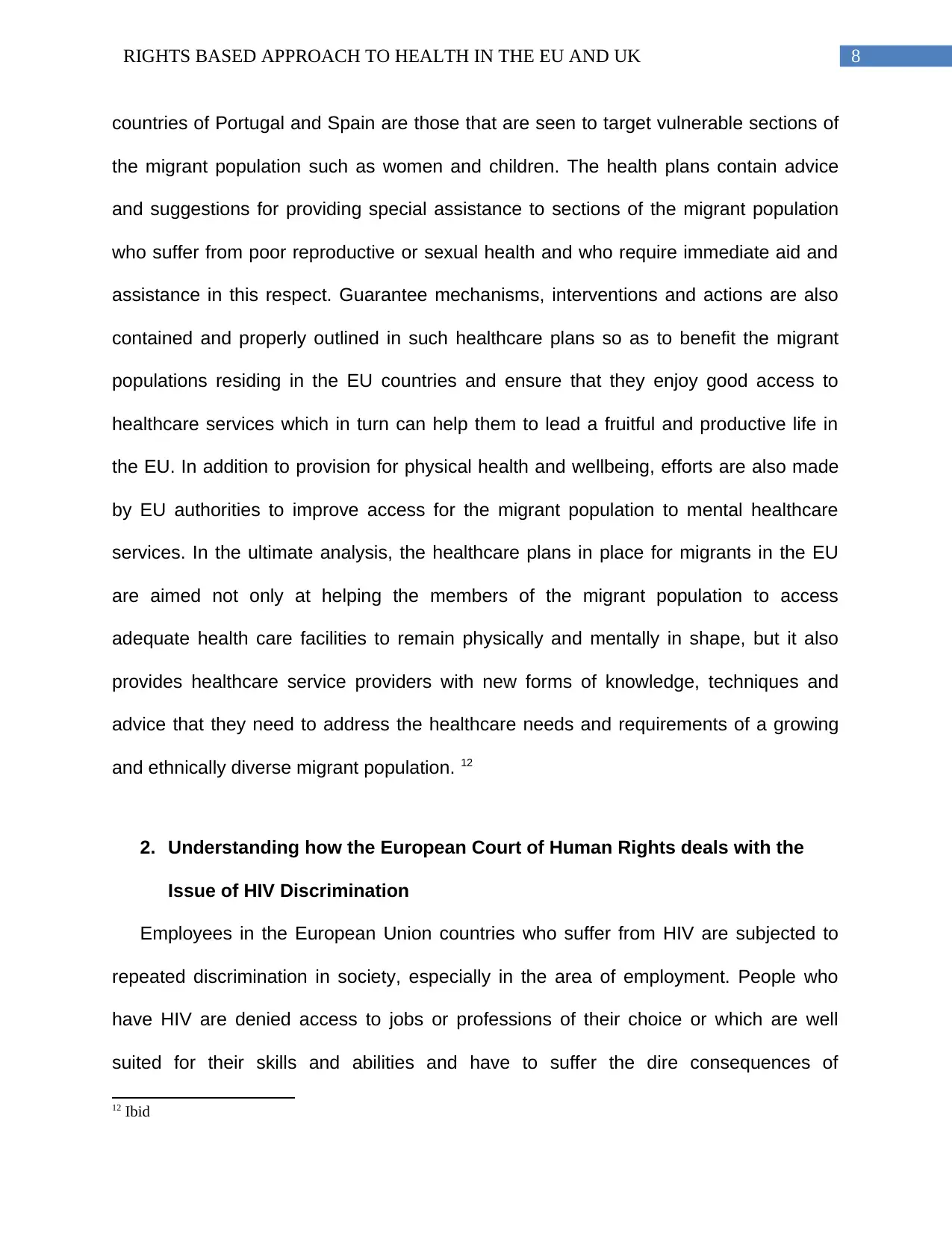
8RIGHTS BASED APPROACH TO HEALTH IN THE EU AND UK
countries of Portugal and Spain are those that are seen to target vulnerable sections of
the migrant population such as women and children. The health plans contain advice
and suggestions for providing special assistance to sections of the migrant population
who suffer from poor reproductive or sexual health and who require immediate aid and
assistance in this respect. Guarantee mechanisms, interventions and actions are also
contained and properly outlined in such healthcare plans so as to benefit the migrant
populations residing in the EU countries and ensure that they enjoy good access to
healthcare services which in turn can help them to lead a fruitful and productive life in
the EU. In addition to provision for physical health and wellbeing, efforts are also made
by EU authorities to improve access for the migrant population to mental healthcare
services. In the ultimate analysis, the healthcare plans in place for migrants in the EU
are aimed not only at helping the members of the migrant population to access
adequate health care facilities to remain physically and mentally in shape, but it also
provides healthcare service providers with new forms of knowledge, techniques and
advice that they need to address the healthcare needs and requirements of a growing
and ethnically diverse migrant population. 12
2. Understanding how the European Court of Human Rights deals with the
Issue of HIV Discrimination
Employees in the European Union countries who suffer from HIV are subjected to
repeated discrimination in society, especially in the area of employment. People who
have HIV are denied access to jobs or professions of their choice or which are well
suited for their skills and abilities and have to suffer the dire consequences of
12 Ibid
countries of Portugal and Spain are those that are seen to target vulnerable sections of
the migrant population such as women and children. The health plans contain advice
and suggestions for providing special assistance to sections of the migrant population
who suffer from poor reproductive or sexual health and who require immediate aid and
assistance in this respect. Guarantee mechanisms, interventions and actions are also
contained and properly outlined in such healthcare plans so as to benefit the migrant
populations residing in the EU countries and ensure that they enjoy good access to
healthcare services which in turn can help them to lead a fruitful and productive life in
the EU. In addition to provision for physical health and wellbeing, efforts are also made
by EU authorities to improve access for the migrant population to mental healthcare
services. In the ultimate analysis, the healthcare plans in place for migrants in the EU
are aimed not only at helping the members of the migrant population to access
adequate health care facilities to remain physically and mentally in shape, but it also
provides healthcare service providers with new forms of knowledge, techniques and
advice that they need to address the healthcare needs and requirements of a growing
and ethnically diverse migrant population. 12
2. Understanding how the European Court of Human Rights deals with the
Issue of HIV Discrimination
Employees in the European Union countries who suffer from HIV are subjected to
repeated discrimination in society, especially in the area of employment. People who
have HIV are denied access to jobs or professions of their choice or which are well
suited for their skills and abilities and have to suffer the dire consequences of
12 Ibid
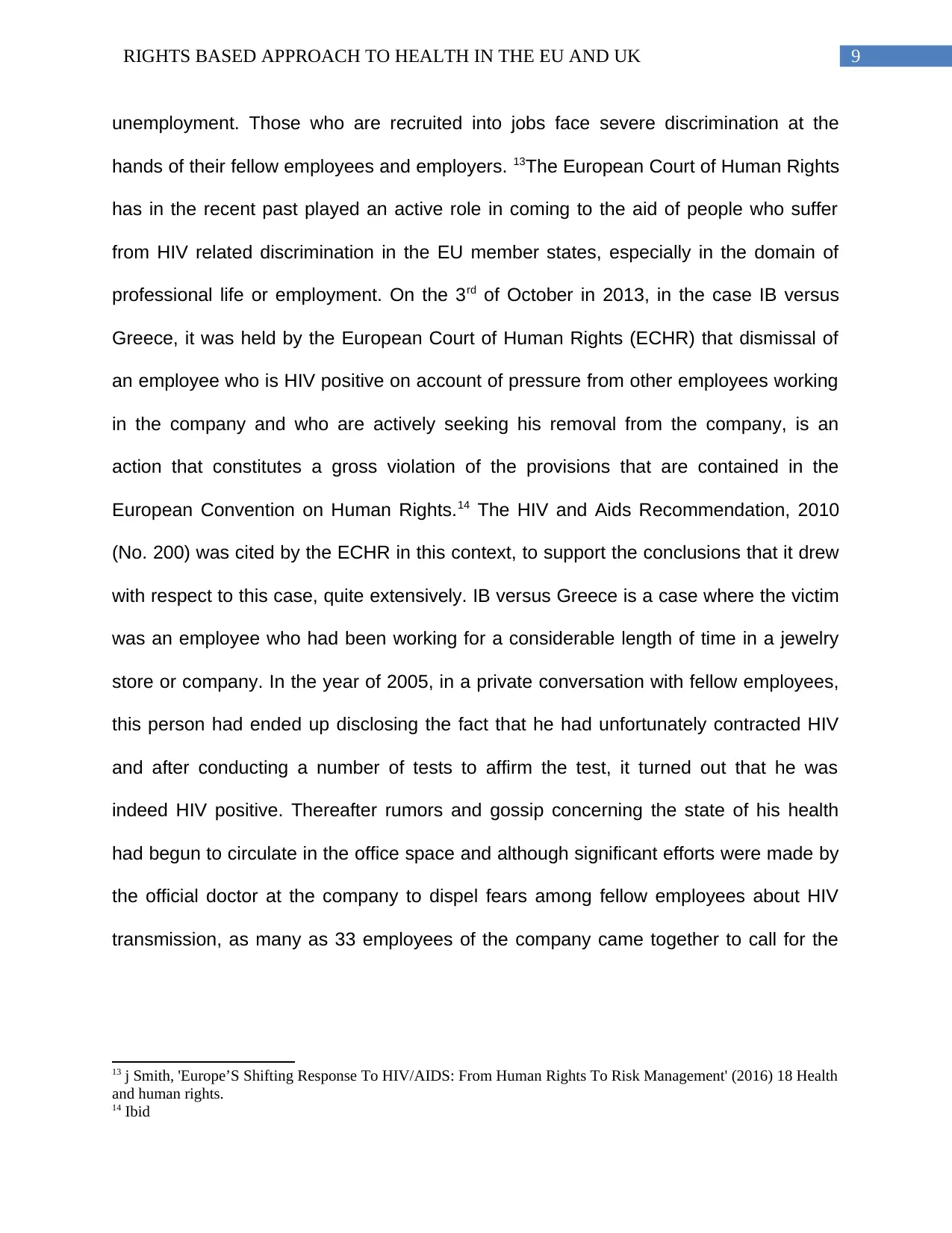
9RIGHTS BASED APPROACH TO HEALTH IN THE EU AND UK
unemployment. Those who are recruited into jobs face severe discrimination at the
hands of their fellow employees and employers. 13The European Court of Human Rights
has in the recent past played an active role in coming to the aid of people who suffer
from HIV related discrimination in the EU member states, especially in the domain of
professional life or employment. On the 3rd of October in 2013, in the case IB versus
Greece, it was held by the European Court of Human Rights (ECHR) that dismissal of
an employee who is HIV positive on account of pressure from other employees working
in the company and who are actively seeking his removal from the company, is an
action that constitutes a gross violation of the provisions that are contained in the
European Convention on Human Rights.14 The HIV and Aids Recommendation, 2010
(No. 200) was cited by the ECHR in this context, to support the conclusions that it drew
with respect to this case, quite extensively. IB versus Greece is a case where the victim
was an employee who had been working for a considerable length of time in a jewelry
store or company. In the year of 2005, in a private conversation with fellow employees,
this person had ended up disclosing the fact that he had unfortunately contracted HIV
and after conducting a number of tests to affirm the test, it turned out that he was
indeed HIV positive. Thereafter rumors and gossip concerning the state of his health
had begun to circulate in the office space and although significant efforts were made by
the official doctor at the company to dispel fears among fellow employees about HIV
transmission, as many as 33 employees of the company came together to call for the
13 j Smith, 'Europe’S Shifting Response To HIV/AIDS: From Human Rights To Risk Management' (2016) 18 Health
and human rights.
14 Ibid
unemployment. Those who are recruited into jobs face severe discrimination at the
hands of their fellow employees and employers. 13The European Court of Human Rights
has in the recent past played an active role in coming to the aid of people who suffer
from HIV related discrimination in the EU member states, especially in the domain of
professional life or employment. On the 3rd of October in 2013, in the case IB versus
Greece, it was held by the European Court of Human Rights (ECHR) that dismissal of
an employee who is HIV positive on account of pressure from other employees working
in the company and who are actively seeking his removal from the company, is an
action that constitutes a gross violation of the provisions that are contained in the
European Convention on Human Rights.14 The HIV and Aids Recommendation, 2010
(No. 200) was cited by the ECHR in this context, to support the conclusions that it drew
with respect to this case, quite extensively. IB versus Greece is a case where the victim
was an employee who had been working for a considerable length of time in a jewelry
store or company. In the year of 2005, in a private conversation with fellow employees,
this person had ended up disclosing the fact that he had unfortunately contracted HIV
and after conducting a number of tests to affirm the test, it turned out that he was
indeed HIV positive. Thereafter rumors and gossip concerning the state of his health
had begun to circulate in the office space and although significant efforts were made by
the official doctor at the company to dispel fears among fellow employees about HIV
transmission, as many as 33 employees of the company came together to call for the
13 j Smith, 'Europe’S Shifting Response To HIV/AIDS: From Human Rights To Risk Management' (2016) 18 Health
and human rights.
14 Ibid
⊘ This is a preview!⊘
Do you want full access?
Subscribe today to unlock all pages.

Trusted by 1+ million students worldwide
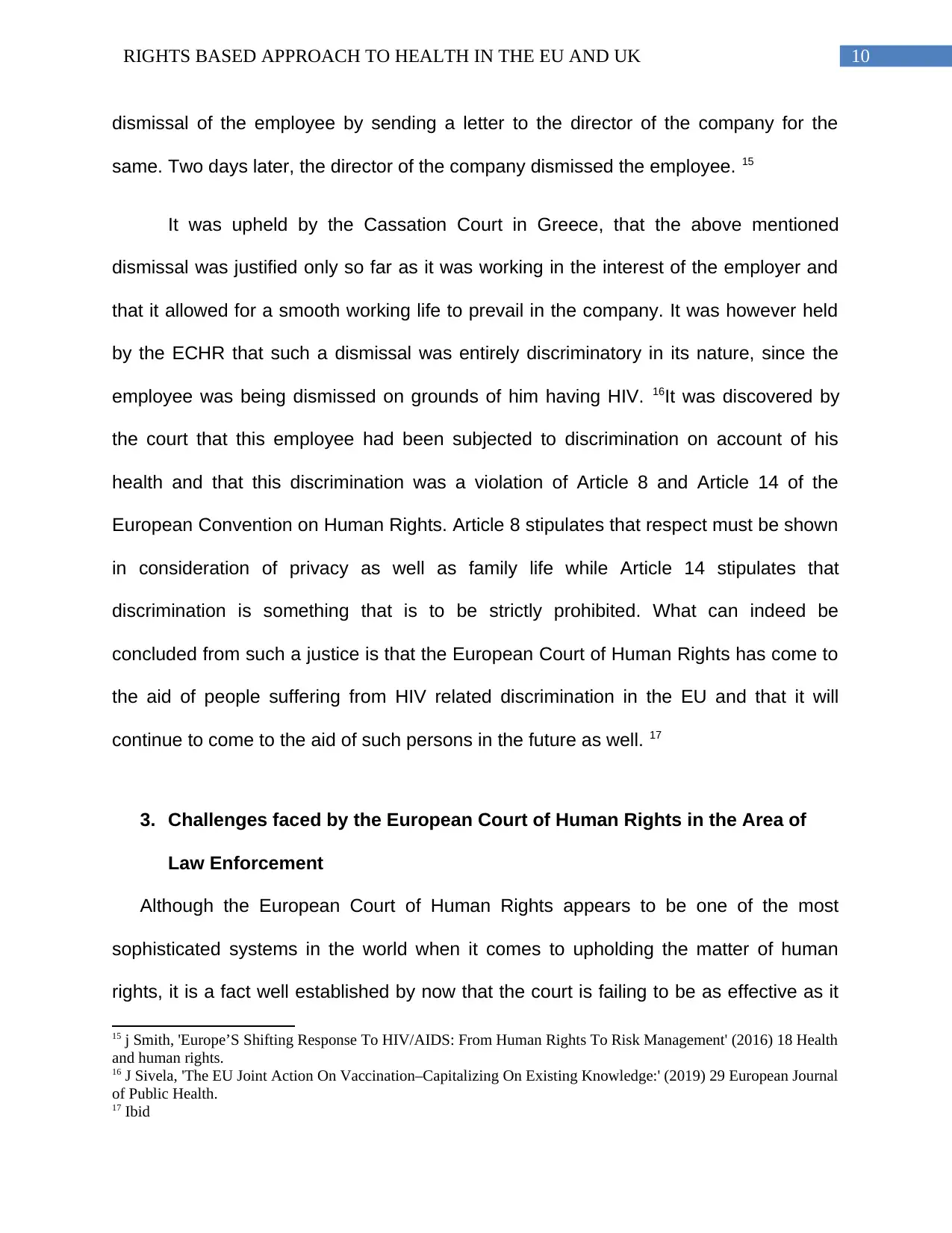
10RIGHTS BASED APPROACH TO HEALTH IN THE EU AND UK
dismissal of the employee by sending a letter to the director of the company for the
same. Two days later, the director of the company dismissed the employee. 15
It was upheld by the Cassation Court in Greece, that the above mentioned
dismissal was justified only so far as it was working in the interest of the employer and
that it allowed for a smooth working life to prevail in the company. It was however held
by the ECHR that such a dismissal was entirely discriminatory in its nature, since the
employee was being dismissed on grounds of him having HIV. 16It was discovered by
the court that this employee had been subjected to discrimination on account of his
health and that this discrimination was a violation of Article 8 and Article 14 of the
European Convention on Human Rights. Article 8 stipulates that respect must be shown
in consideration of privacy as well as family life while Article 14 stipulates that
discrimination is something that is to be strictly prohibited. What can indeed be
concluded from such a justice is that the European Court of Human Rights has come to
the aid of people suffering from HIV related discrimination in the EU and that it will
continue to come to the aid of such persons in the future as well. 17
3. Challenges faced by the European Court of Human Rights in the Area of
Law Enforcement
Although the European Court of Human Rights appears to be one of the most
sophisticated systems in the world when it comes to upholding the matter of human
rights, it is a fact well established by now that the court is failing to be as effective as it
15 j Smith, 'Europe’S Shifting Response To HIV/AIDS: From Human Rights To Risk Management' (2016) 18 Health
and human rights.
16 J Sivela, 'The EU Joint Action On Vaccination–Capitalizing On Existing Knowledge:' (2019) 29 European Journal
of Public Health.
17 Ibid
dismissal of the employee by sending a letter to the director of the company for the
same. Two days later, the director of the company dismissed the employee. 15
It was upheld by the Cassation Court in Greece, that the above mentioned
dismissal was justified only so far as it was working in the interest of the employer and
that it allowed for a smooth working life to prevail in the company. It was however held
by the ECHR that such a dismissal was entirely discriminatory in its nature, since the
employee was being dismissed on grounds of him having HIV. 16It was discovered by
the court that this employee had been subjected to discrimination on account of his
health and that this discrimination was a violation of Article 8 and Article 14 of the
European Convention on Human Rights. Article 8 stipulates that respect must be shown
in consideration of privacy as well as family life while Article 14 stipulates that
discrimination is something that is to be strictly prohibited. What can indeed be
concluded from such a justice is that the European Court of Human Rights has come to
the aid of people suffering from HIV related discrimination in the EU and that it will
continue to come to the aid of such persons in the future as well. 17
3. Challenges faced by the European Court of Human Rights in the Area of
Law Enforcement
Although the European Court of Human Rights appears to be one of the most
sophisticated systems in the world when it comes to upholding the matter of human
rights, it is a fact well established by now that the court is failing to be as effective as it
15 j Smith, 'Europe’S Shifting Response To HIV/AIDS: From Human Rights To Risk Management' (2016) 18 Health
and human rights.
16 J Sivela, 'The EU Joint Action On Vaccination–Capitalizing On Existing Knowledge:' (2019) 29 European Journal
of Public Health.
17 Ibid
Paraphrase This Document
Need a fresh take? Get an instant paraphrase of this document with our AI Paraphraser
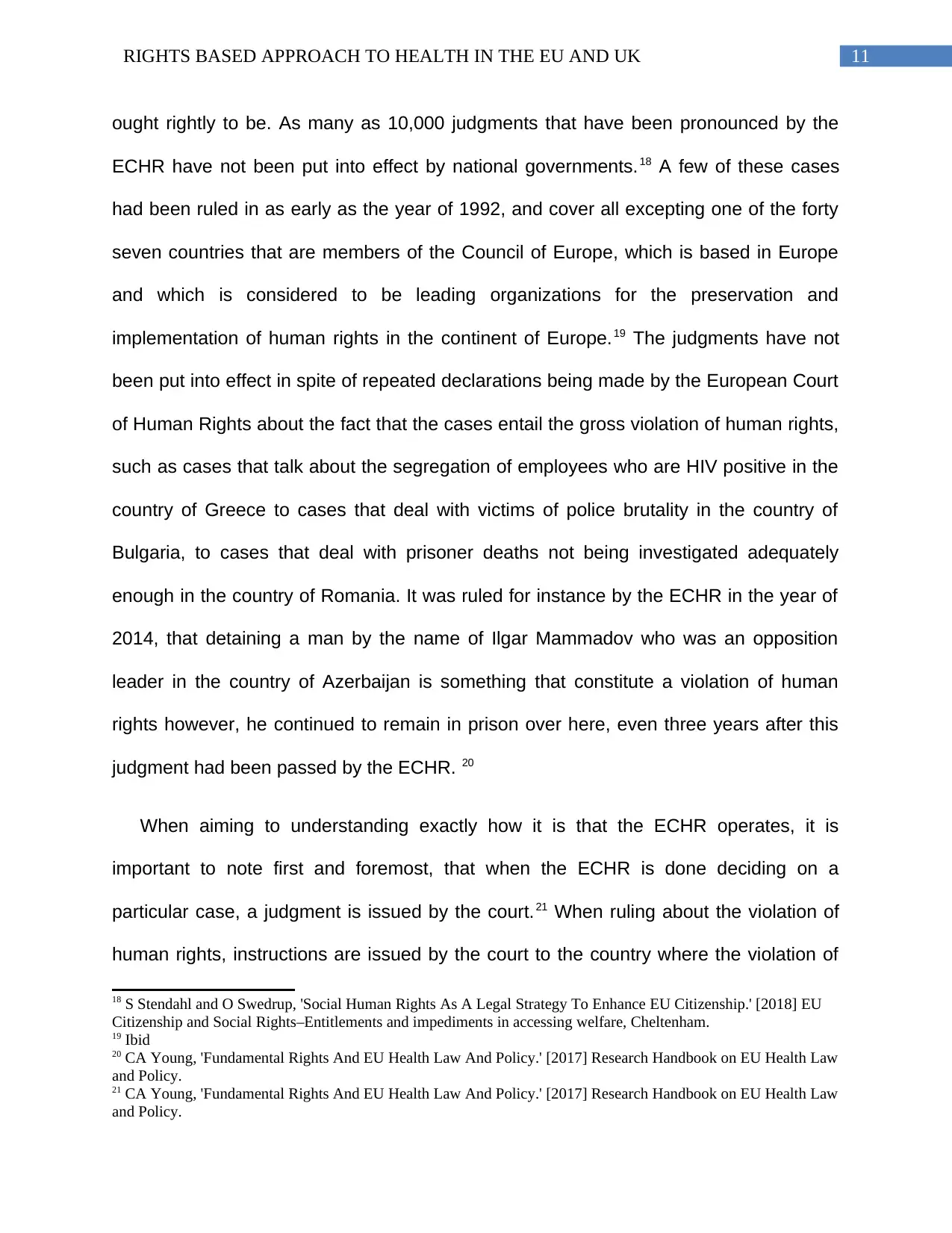
11RIGHTS BASED APPROACH TO HEALTH IN THE EU AND UK
ought rightly to be. As many as 10,000 judgments that have been pronounced by the
ECHR have not been put into effect by national governments.18 A few of these cases
had been ruled in as early as the year of 1992, and cover all excepting one of the forty
seven countries that are members of the Council of Europe, which is based in Europe
and which is considered to be leading organizations for the preservation and
implementation of human rights in the continent of Europe.19 The judgments have not
been put into effect in spite of repeated declarations being made by the European Court
of Human Rights about the fact that the cases entail the gross violation of human rights,
such as cases that talk about the segregation of employees who are HIV positive in the
country of Greece to cases that deal with victims of police brutality in the country of
Bulgaria, to cases that deal with prisoner deaths not being investigated adequately
enough in the country of Romania. It was ruled for instance by the ECHR in the year of
2014, that detaining a man by the name of Ilgar Mammadov who was an opposition
leader in the country of Azerbaijan is something that constitute a violation of human
rights however, he continued to remain in prison over here, even three years after this
judgment had been passed by the ECHR. 20
When aiming to understanding exactly how it is that the ECHR operates, it is
important to note first and foremost, that when the ECHR is done deciding on a
particular case, a judgment is issued by the court.21 When ruling about the violation of
human rights, instructions are issued by the court to the country where the violation of
18 S Stendahl and O Swedrup, 'Social Human Rights As A Legal Strategy To Enhance EU Citizenship.' [2018] EU
Citizenship and Social Rights–Entitlements and impediments in accessing welfare, Cheltenham.
19 Ibid
20 CA Young, 'Fundamental Rights And EU Health Law And Policy.' [2017] Research Handbook on EU Health Law
and Policy.
21 CA Young, 'Fundamental Rights And EU Health Law And Policy.' [2017] Research Handbook on EU Health Law
and Policy.
ought rightly to be. As many as 10,000 judgments that have been pronounced by the
ECHR have not been put into effect by national governments.18 A few of these cases
had been ruled in as early as the year of 1992, and cover all excepting one of the forty
seven countries that are members of the Council of Europe, which is based in Europe
and which is considered to be leading organizations for the preservation and
implementation of human rights in the continent of Europe.19 The judgments have not
been put into effect in spite of repeated declarations being made by the European Court
of Human Rights about the fact that the cases entail the gross violation of human rights,
such as cases that talk about the segregation of employees who are HIV positive in the
country of Greece to cases that deal with victims of police brutality in the country of
Bulgaria, to cases that deal with prisoner deaths not being investigated adequately
enough in the country of Romania. It was ruled for instance by the ECHR in the year of
2014, that detaining a man by the name of Ilgar Mammadov who was an opposition
leader in the country of Azerbaijan is something that constitute a violation of human
rights however, he continued to remain in prison over here, even three years after this
judgment had been passed by the ECHR. 20
When aiming to understanding exactly how it is that the ECHR operates, it is
important to note first and foremost, that when the ECHR is done deciding on a
particular case, a judgment is issued by the court.21 When ruling about the violation of
human rights, instructions are issued by the court to the country where the violation of
18 S Stendahl and O Swedrup, 'Social Human Rights As A Legal Strategy To Enhance EU Citizenship.' [2018] EU
Citizenship and Social Rights–Entitlements and impediments in accessing welfare, Cheltenham.
19 Ibid
20 CA Young, 'Fundamental Rights And EU Health Law And Policy.' [2017] Research Handbook on EU Health Law
and Policy.
21 CA Young, 'Fundamental Rights And EU Health Law And Policy.' [2017] Research Handbook on EU Health Law
and Policy.
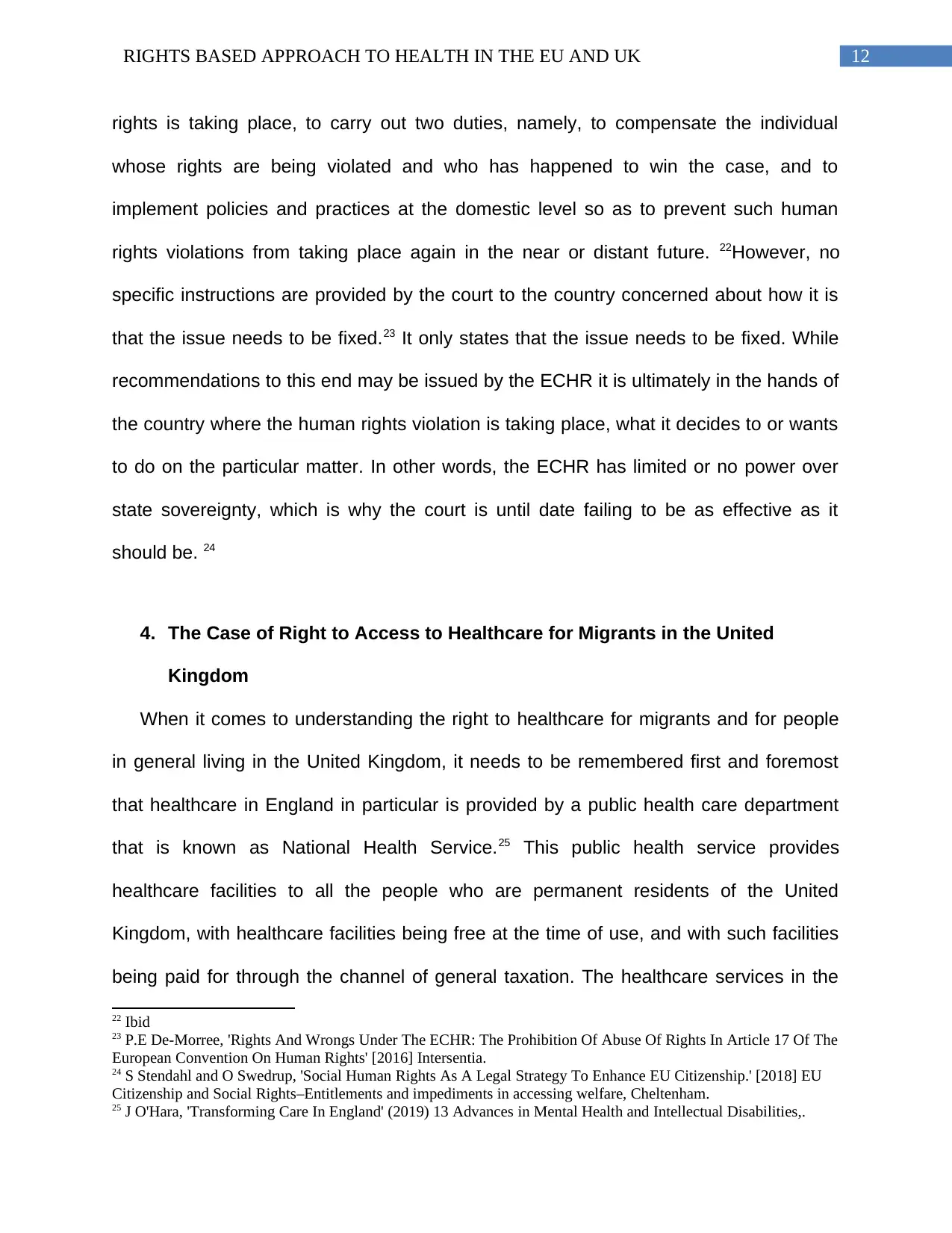
12RIGHTS BASED APPROACH TO HEALTH IN THE EU AND UK
rights is taking place, to carry out two duties, namely, to compensate the individual
whose rights are being violated and who has happened to win the case, and to
implement policies and practices at the domestic level so as to prevent such human
rights violations from taking place again in the near or distant future. 22However, no
specific instructions are provided by the court to the country concerned about how it is
that the issue needs to be fixed.23 It only states that the issue needs to be fixed. While
recommendations to this end may be issued by the ECHR it is ultimately in the hands of
the country where the human rights violation is taking place, what it decides to or wants
to do on the particular matter. In other words, the ECHR has limited or no power over
state sovereignty, which is why the court is until date failing to be as effective as it
should be. 24
4. The Case of Right to Access to Healthcare for Migrants in the United
Kingdom
When it comes to understanding the right to healthcare for migrants and for people
in general living in the United Kingdom, it needs to be remembered first and foremost
that healthcare in England in particular is provided by a public health care department
that is known as National Health Service.25 This public health service provides
healthcare facilities to all the people who are permanent residents of the United
Kingdom, with healthcare facilities being free at the time of use, and with such facilities
being paid for through the channel of general taxation. The healthcare services in the
22 Ibid
23 P.E De-Morree, 'Rights And Wrongs Under The ECHR: The Prohibition Of Abuse Of Rights In Article 17 Of The
European Convention On Human Rights' [2016] Intersentia.
24 S Stendahl and O Swedrup, 'Social Human Rights As A Legal Strategy To Enhance EU Citizenship.' [2018] EU
Citizenship and Social Rights–Entitlements and impediments in accessing welfare, Cheltenham.
25 J O'Hara, 'Transforming Care In England' (2019) 13 Advances in Mental Health and Intellectual Disabilities,.
rights is taking place, to carry out two duties, namely, to compensate the individual
whose rights are being violated and who has happened to win the case, and to
implement policies and practices at the domestic level so as to prevent such human
rights violations from taking place again in the near or distant future. 22However, no
specific instructions are provided by the court to the country concerned about how it is
that the issue needs to be fixed.23 It only states that the issue needs to be fixed. While
recommendations to this end may be issued by the ECHR it is ultimately in the hands of
the country where the human rights violation is taking place, what it decides to or wants
to do on the particular matter. In other words, the ECHR has limited or no power over
state sovereignty, which is why the court is until date failing to be as effective as it
should be. 24
4. The Case of Right to Access to Healthcare for Migrants in the United
Kingdom
When it comes to understanding the right to healthcare for migrants and for people
in general living in the United Kingdom, it needs to be remembered first and foremost
that healthcare in England in particular is provided by a public health care department
that is known as National Health Service.25 This public health service provides
healthcare facilities to all the people who are permanent residents of the United
Kingdom, with healthcare facilities being free at the time of use, and with such facilities
being paid for through the channel of general taxation. The healthcare services in the
22 Ibid
23 P.E De-Morree, 'Rights And Wrongs Under The ECHR: The Prohibition Of Abuse Of Rights In Article 17 Of The
European Convention On Human Rights' [2016] Intersentia.
24 S Stendahl and O Swedrup, 'Social Human Rights As A Legal Strategy To Enhance EU Citizenship.' [2018] EU
Citizenship and Social Rights–Entitlements and impediments in accessing welfare, Cheltenham.
25 J O'Hara, 'Transforming Care In England' (2019) 13 Advances in Mental Health and Intellectual Disabilities,.
⊘ This is a preview!⊘
Do you want full access?
Subscribe today to unlock all pages.

Trusted by 1+ million students worldwide
1 out of 19
Related Documents
Your All-in-One AI-Powered Toolkit for Academic Success.
+13062052269
info@desklib.com
Available 24*7 on WhatsApp / Email
![[object Object]](/_next/static/media/star-bottom.7253800d.svg)
Unlock your academic potential
Copyright © 2020–2025 A2Z Services. All Rights Reserved. Developed and managed by ZUCOL.





